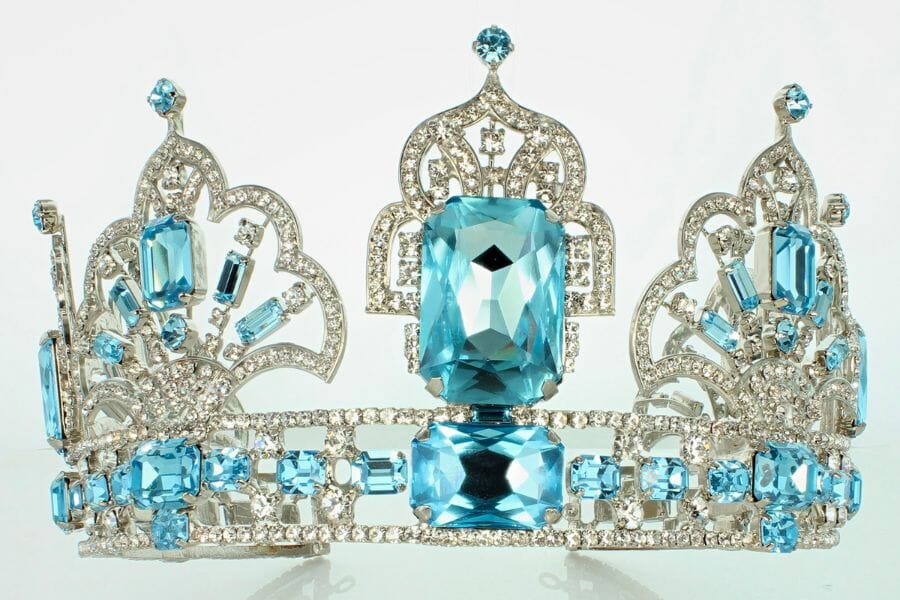Making a splash in the world of gemstones is the cool and breezy Aquamarine. With its delicate blue hue that sparkles like the ocean on a sunny day, Aquamarine is one of the most popular gems around. It’s known for its beauty, durability, and versatility, making it a valuable addition to any collection.
But there’s more to Aquamarine than meets the eye. Did you know that it’s also believed to have healing properties? Plus, it’s the birthstone for March, so if you’re a March baby, you’re surely interested to know how expensive these gems are.
And even if you’re not, but you’re just as curious to learn more about this amazing gemstone, read on because we’re about to dive deep into all the fascinating details of how much Aquamarine is really worth.
What Aquamarine Is
With its breathtaking hue, Aquamarine is the ultimate gem for sea-lovers and mermaids at heart! This precious gem is a member of the beryl family, and its name literally means “sea water” in Latin. Its color is an incredible shade of blue that ranges from the palest sky blue to the deepest ocean blue, sometimes with a hint of green or gray.
With its wide range of colors and clarity come different price tags, which we’ll all be sharing with you in this article.
Top Color Aquamarine
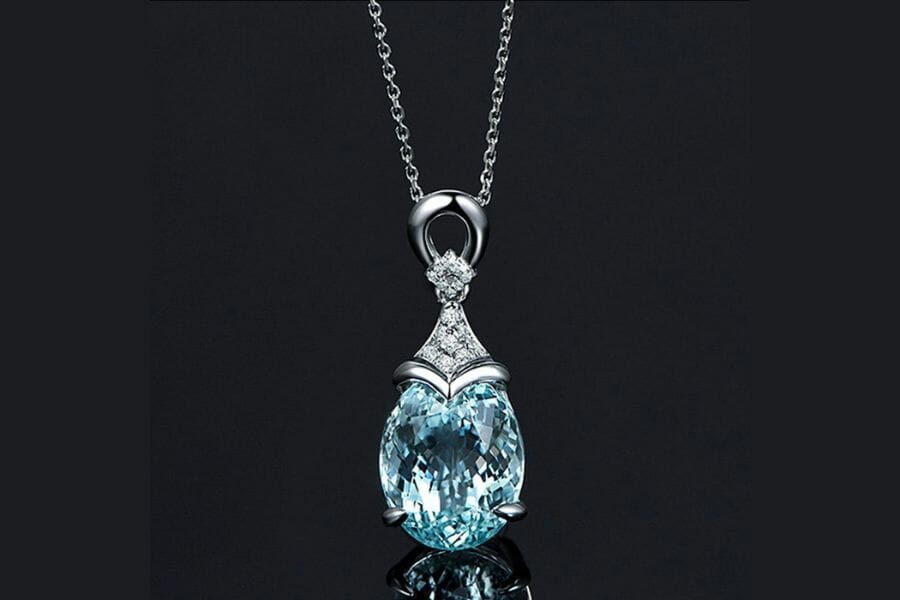
When it comes to Aquamarine, the color is everything! A top-color Aquamarine is a stunning sight to behold, with its delicate yet vivid blue hue that sparkles like a clear sky on a sunny day. In fact, the best ones have a highly sought-after “Santa Maria” blue color, named after the famous Brazilian mine where they were first discovered.
In terms of darkness, a top-color Aquamarine will have a light, medium, and dark tone, which means that the blue color is rich and saturated without being too dark or too light. This creates a perfect balance between the intensity of the color and its transparency.
But what really sets a top-color Aquamarine apart is its clarity. The best samples will have very few inclusions, if any at all, and will be almost completely transparent. This allows the light to pass through the gemstone, creating a beautiful brilliance and sparkle that is truly breathtaking.
How much is top color aquamarine worth
A top color Aquamarine comes in varying shades of blue. And each of these shades command different prices, as you will see below.
| Color | Cut | Price (Per Carat) |
| Dark | Faceted | $200 – $600 |
| Medium | Faceted | $80 – $400 |
| Light | Faceted | $5 – $50 |
Plain Aquamarine
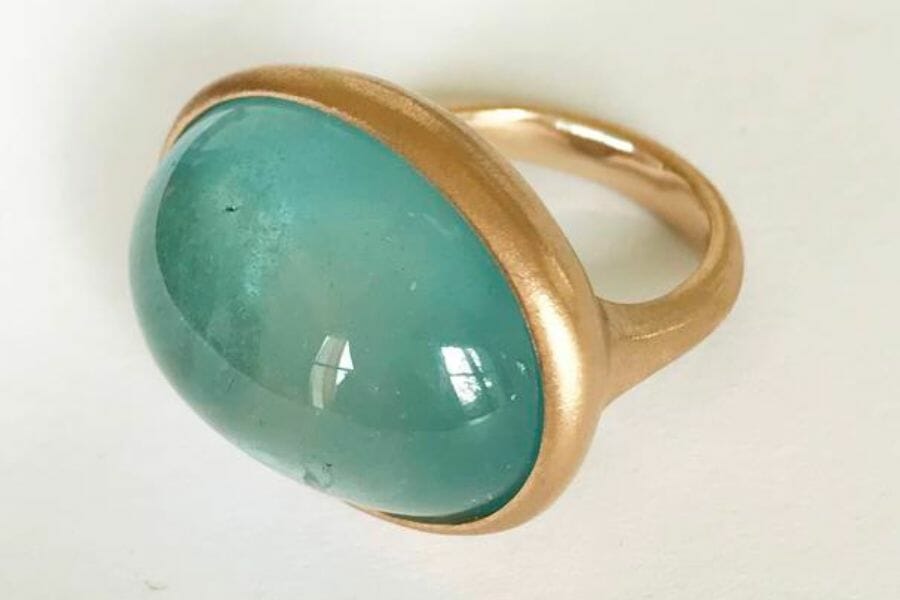
A plain Aquamarine is a thing of understated and classic beauty, even without the intensity of color or clarity that the Top Color one has.
One of the great things about plain Aquamarine is that it can be found in a variety of sizes and shapes, making it a popular choice for jewelry designers who want to create unique and eye-catching pieces. Plus, since it’s a relatively affordable gemstone, it’s a great option for those who want to add some sparkle to their collection without breaking the bank.
How much is plain aquamarine worth
A plain Aquamarine cabochon, just like center stone in the photo above, is worth $10 to $50 per carat.
Cat’s Eye
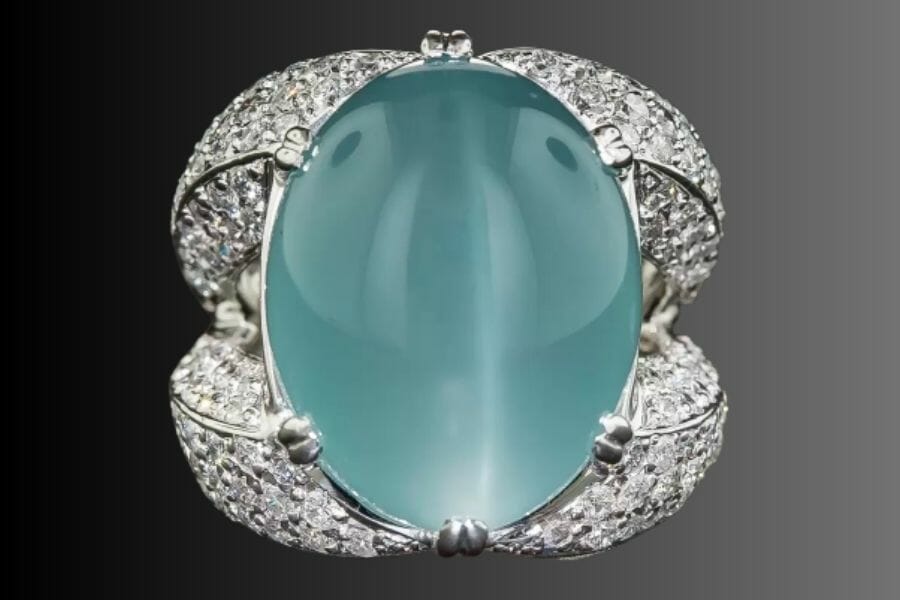
Cat’s Eye is a unique and stunning Aquamarine that displays a mesmerizing optical effect known as chatoyancy. This effect creates a band of light that appears to move across the surface of the gemstone, similar to the way a cat’s eye reflects light.
This cat’s eye effect is caused by the presence of needle-like inclusions that reflect light in a particular direction, creating a line of light that runs perpendicular to the direction of the inclusions. It’s particularly striking when the gemstone is cut into a cabochon shape (just like what’s shown in the photo), which showcases the chatoyancy to its fullest potential.
In terms of color, a Cat’s Eye Aquamarine will have the same delicate blue or greenish-blue hue as other Aquamarine, but the chatoyancy adds an extra dimension of beauty and intrigue. This makes it a popular choice for jewelry lovers who want to add a unique and eye-catching piece to their collection.
How much is cat’s eye worth
Compared to a plain Aquamarine, Cat’e Eye is relatively worth more. This Aquamarine’s price is set at $40 to $400 per carat.
Star Aquamarine
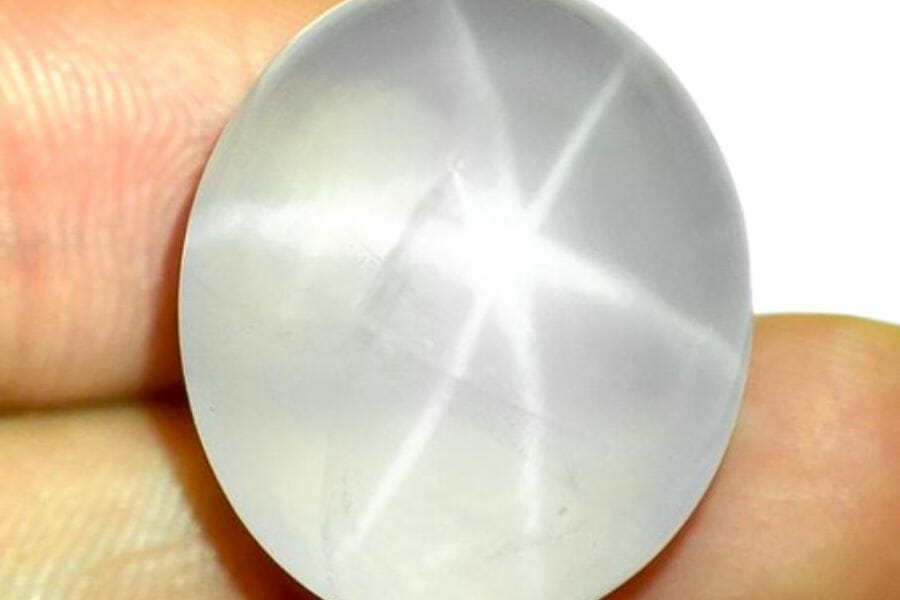
In nephrite, black coloration is primarily due to the presence of high concentrations of iron or graphite inclusions. For black jadeite, the dark hues result from the presence of microscopic inclusions, such as iron-rich minerals. These inclusions or trace elements absorb light, giving the jade its distinctive black appearance.
How much is star aquamarine worth
Since it’s rarer than Cat’s Eye, Star Aquamarine is sold at a more premium price. However, as of writing, there is no specific data available in the market how much it specifically sells per carat.
Why Aquamarine Is So Expensive
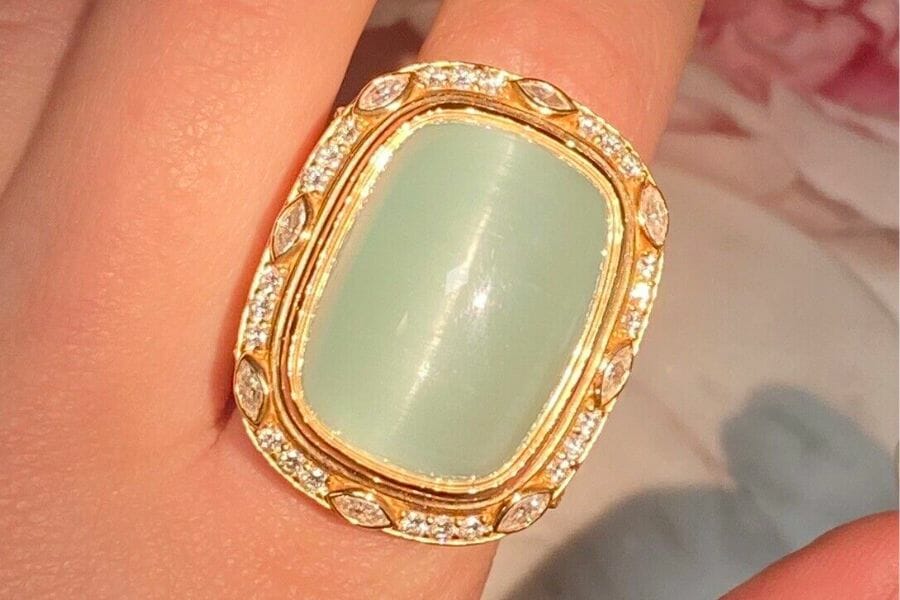
Cherished for its beauty, versatility, and soothing energy, this blue or greenish-blue beryl gemstone is beloved by jewelry designers and gemstone enthusiasts, and for good reason!
First and foremost, Aquamarine is valued for its stunning color. The best ones have a delicate yet vivid blue hue that can range from pale sky blue to deep ocean blue. The color is so captivating that it has even been named after the sea itself, as we’ve discussed above. Plus, the color is said to be reminiscent of tropical waters and blue skies, making it a perfect gemstone for beach lovers.
Aside from its beauty, Aquamarine is also highly valued for its versatility. It can be found in a range of sizes and shapes, and can be cut and polished into a variety of styles to suit any taste. From classic solitaire rings to unique pendant designs, Aquamarine can be used to create stunning and one-of-a-kind pieces of jewelry.
Another reason for Aquamarine’s value is its soothing energy. It’s believed to promote peace, calmness, and communication, making it a popular gemstone for meditation and spiritual practices. Plus, it is said to have healing properties that can benefit the throat, heart, and immune system.
Now, you may already know that it’s fairly common for Aquamarine to be confused with other rocks and minerals. If you’re not 100% sure that what you have is Aquamarine, check out our guides below:
How To Determine The Value Of Aquamarine
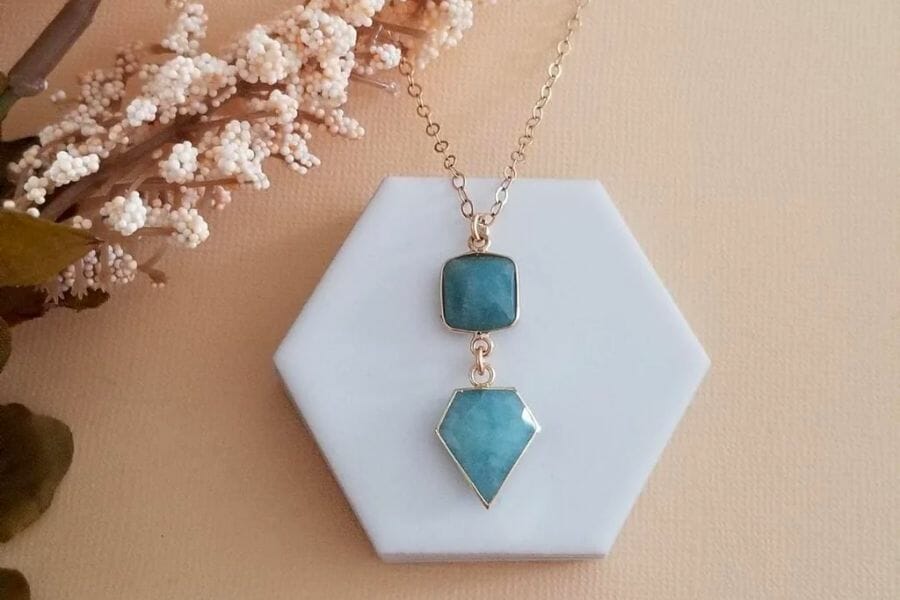
In determining Aquamarine’s price and value, it’s important to take note of the different factors that immensely influence it, such as the following:
Color
As we’ve mentioned above, color is the most important factor in determining the value of an Aquamarine. The most valuable samples have a deep blue color, with minimal green or gray tones. Stones that are too light or too dark may be less valuable, as they are less desirable for jewelry.
Clarity
Next to color, clarity is another important factor to consider. Aquamarine gems that are free from inclusions, cracks, or other blemishes are considered to be of higher quality and therefore more valuable.
However, some inclusions that create the cat’s eye effect or star effect can actually enhance the value of the stone if they are desirable. Which is why we included the next two factors below.
Chatoyancy
Chatoyancy, also known as cat’s eye effect, can affect the price of Aquamarine, especially depending on the rarity and quality of the effect.
Chatoyancy is a unique optical effect in which a band of light appears to move across the surface of the stone, creating a striking resemblance to a cat’s eye. The more prominent and well-defined the cat’s eye effect, the more valuable the gemstone will likely be.
Asterism
Also known as star effect, Asterism is caused by needle-like inclusions that intersect at regular angles within the crystal structure of the Aquamarine. When a polished stone is viewed under certain lighting conditions, a six-rayed star pattern appears on its surface.
The value of an Aquamarine with asterism will depend on a number of factors, including the intensity and quality of the effect, the size and overall quality of the stone, and the preferences of the buyer. Generally speaking, though, the more prominent and well-defined the star pattern is, the more valuable the Aquamarine will be.
Cut
As with other gemstones, the cut of an Aquamarine is also important. A well-cut gemstone will have good proportions, symmetry, and a high level of brilliance. A poorly cut one may not show off the beauty and color of the gem to its fullest potential, thereby negatively affecting the Aquamarine’s value.
Type
The type of Aquamarine gemstone, whether natural or synthetic, can have a significant impact on its price.
Generally speaking, natural Aquamarine, which are formed over millions of years through natural geological processes, are more valuable than synthetic alternatives. While synthetic Aquamarines are produced to have the same physical and chemical properties as natural ones, they do not have the same intrinsic value or historical significance.
Treatments and Enhancements
Natural and untreated Aquamarines are considered more valuable than treated or enhanced stones. But there are some exceptions to this rule.
Heat treatment is a common method used to enhance the color of Aquamarines. By subjecting the gem to high temperatures, the color can be intensified, making it more vibrant and desirable. Other treatments include irradiation, which changes the color of the gem, and coating, which improves its clarity or luster.
It is worth noting that minor treatments, like gentle heating or polishing to remove minor blemishes, may not have as significant of an impact on the price of the Aquamarine.
Carat and Size
Carat weight and size are also factors in determining the value of an Aquamarine. But since these gems are generally available in large sizes, the increase in price as it gets bigger is not too big. In fact, Aquamarine’s price drops when it gets over 25 carats since it’s considered too big to set and wear on jewelry.
Carving and craftsmanship
Aquamarines that have been expertly carved or crafted will command higher prices than those that have not.
When it comes to carvings, the intricacy and detail of the design will be the primary factors that determine the value of the piece. As for craftsmanship, it’s the quality of the setting and the skill of the jeweler that will be mostly affecting Aquamarine’s price.
Aquamarine Price By Color and Clarity
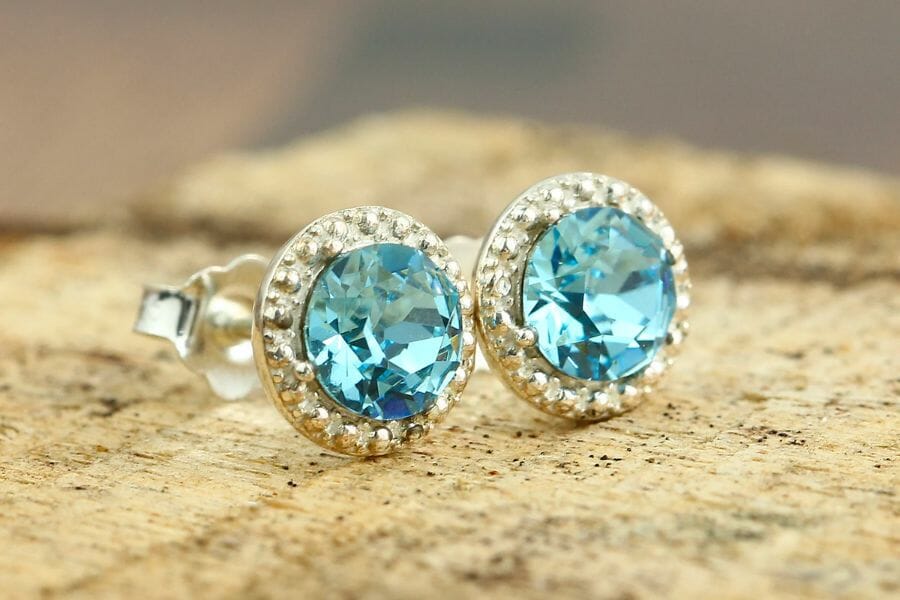
The price of Aquamarine can vary greatly based on several factors as we’ve discussed above, but most crucial of them are the color and clarity. Below are tables discussing the current prices of this gem based on these factors:
Aquamarine values by color
| Color | Cut | Price (Per Carat) |
| Top Color – Dark | Faceted | $200 – $600 |
| Top Color – Medium | Faceted | $80 – $400 |
| Top Color – Light | Faceted | $5 – $50 |
Aquamarine values by clarity
| Clarity | Cut | Price (Per Carat) |
| Plain | Cabochon | $10 – $50 |
| Cat’s Eye | Cabochon | $40 – $400 |
To give you a clearer picture of what Aquamarine’s value is based on different units of measurements, we’ve calculated them for you below.
Aquamarine pricing by unit of measurement
| Measurement | Price |
| A carat of Aquamarine | $5 to $600 |
| A gram of Aquamarine | $25 to $3,000 |
| An ounce of Aquamarine | $709 to $85,049 |
| A kilogram of Aquamarine | $25,000 to $3,000,000 |
| A pound of Aquamarine | $11,340 to $1,360,776 |
| A ton of Aquamarine | $22,679,625 to $2,721,555,000 |
The Most Expensive Aquamarine
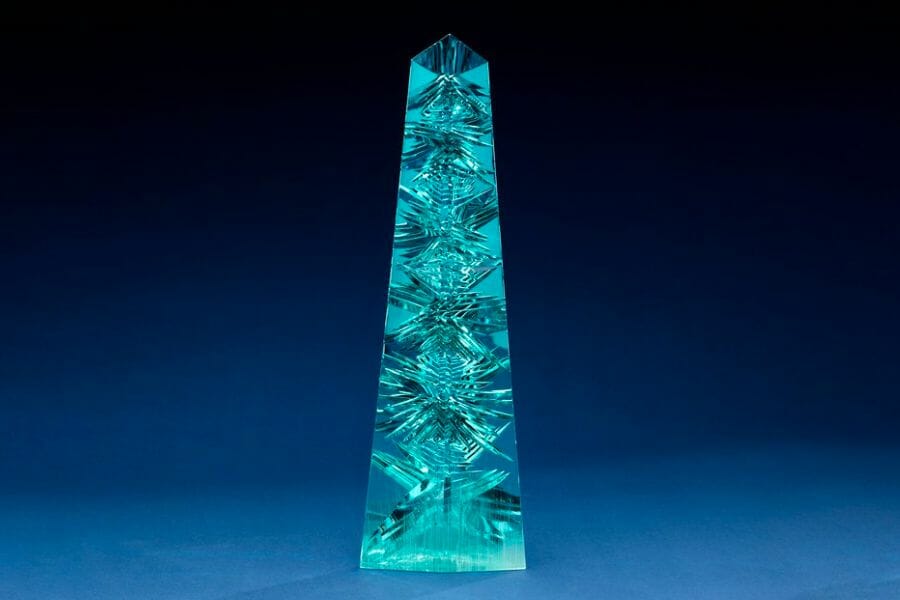
The most expensive Aquamarine gemstone ever sold is the “Dom Pedro” Aquamarine, which is named after Brazil’s first two emperors, Dom Pedro Primeiro and Dom Pedro Segundo. It was discovered in the late 1980s in a Brazilian mine and was eventually purchased by American artist and philanthropist, Jane Mitchell, who commissioned the world-renowned gem cutter, Bernd Munsteiner, to cut and polish the stone into its current shape.
The Dom Pedro Aquamarine is a stunning specimen, weighing in at an impressive 10,363 carats, and standing at 14 inches tall. It boasts of a beautiful blue-green color and is valued not only for its size, but also for its exceptional clarity and unique cut, which features concave facets that enhance the stone’s natural beauty.
The Dom Pedro Aquamarine was sold in 2016 to a private collector for a reported price of $22 million, making it the most expensive Aquamarine gemstone ever sold. It’s now on display at the Smithsonian’s National Museum of Natural History, where it’s viewed and admired by visitors from around the world. The value of the Dom Pedro Aquamarine is a testament to the beauty and rarity of this stunning gemstone and its enduring appeal to collectors and enthusiasts.
How To Get An Appraisal On Your Aquamarine
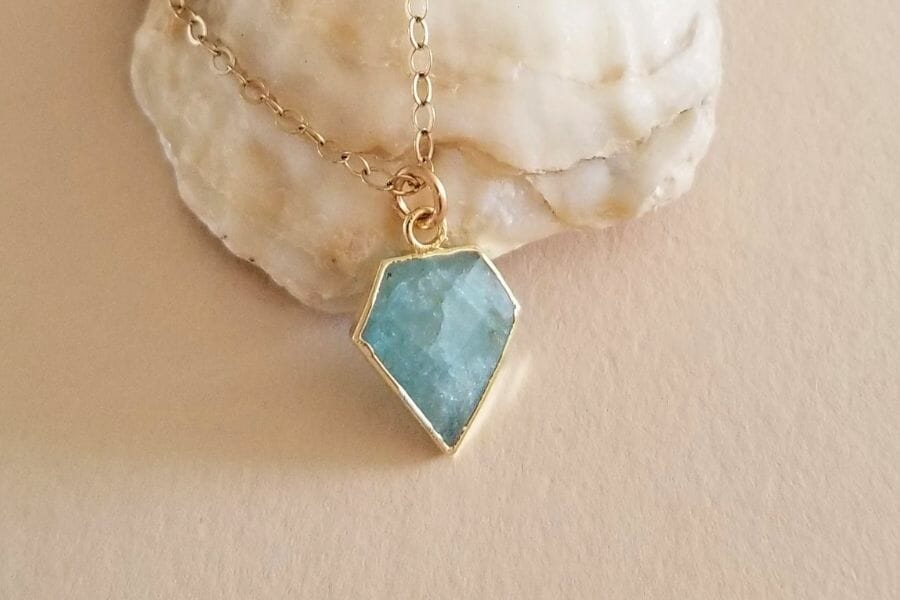
Here are the things you should do to ensure you get an accurate and fair assessment of your Aquamarine’s value if you want to have it appraise.
First, it’s essential to find a reputable appraiser who specializes in gemstones and has experience appraising Aquamarines. You can look for appraisers who are certified by organizations such as the Gemological Institute of America (GIA) or the American Society of Appraisers (ASA).
Before getting your Aquamarine appraised, it’s also a good idea to gather as much information as possible about it, such as its weight, dimensions, and any information you have about its origin or history. This information can help the appraiser make a more accurate assessment of its value.
It’s also important to be aware that the value of an Aquamarine can vary widely depending on different factors that we’ve shared above. Be sure to communicate these details to the appraiser, too.
Overall, getting an appraisal on your Aquamarine is a worthwhile investment, especially if you’re looking to sell the gem or insure it. By taking the time to find a reputable appraiser and providing as much information as possible about it, you can ensure that you get an accurate and fair assessment of its value.

